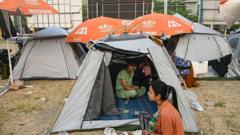Once a quiet corner of Saudi Arabia, the desert landscapes of Al-Ula are rapidly evolving into a tourist hotspot, raising concerns about preserving its untouched charm amidst the kingdom's ongoing push for international tourism.
Al-Ula: A Hidden Gem on the Brink of a Tourism Boom

Al-Ula: A Hidden Gem on the Brink of a Tourism Boom
Saudi Arabia's Al-Ula region is undergoing rapid transformation as it braces for an influx of tourists drawn by its breathtaking landscapes and historical significance.
In recent years, the historic region of Al-Ula in northwest Saudi Arabia has begun its journey from a remote enclave to a burgeoning tourist destination. The enchanting landscapes, known for their towering sandstone and granite formations, are poised to mirror the rapid development seen in more well-known tourist cities like Dubai. With Saudi Arabia's recent embrace of a more open tourism policy, the once recluse wonders of Al-Ula are becoming accessible, yet not without consequences.
As the country strives to reshape its global image, Al-Ula stands at the forefront of this transformation. Visitors are attracted not only by the breathtaking vistas but also by the historical significance of the area, previously a part of the ancient Nabatean empire. The remnants of this civilization manifest in rock-hewn tombs and archaeological sites, drawing parallels to the renowned city of Petra, just north in Jordan.
The changes are already underway, with the establishment of hotels and public art projects that are set to alter the desert landscape. However, tourists with their sights set on capturing the untouched beauty of Al-Ula may soon find themselves sharing the experience with an overwhelming number of fellow travelers. Concerns are mounting about how commercialization could disrupt the area’s unique charm and tranquility.
While some restrictions still linger, such as the ban on alcohol, the Saudi government is keenly aware of its shifting societal norms. Reforms allowing women to drive and travel unaccompanied signify a more progressive future. These cultural shifts could influence the hospitality sector, especially as the nation prepares to host the 2034 World Cup.
Despite facing challenges related to governance and public perception, Al-Ula's allure remains undeniable. As it moves toward becoming one of Saudi Arabia's key tourist attractions, the evolving landscape is a beacon for both adventurers and those seeking the last of the undiscovered gems before they become part of the mainstream travel itinerary.



















